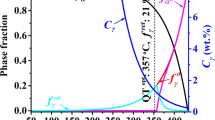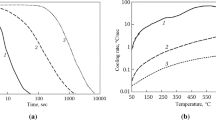Abstract
Immersion quenching is one of the most widely used processes for achieving martensitic and bainitic steels. The efficiency and quality of quenching are generally tested using standard quench probes for obtaining the cooling curves. A host of parameters like quenchant type, steel grade, bath agitation, section thickness, etc., affect the cooling curves. Cooling curve analyses covered under ASTM standards cannot be used to assess the performance of a quenchant for different grades of steel, as they use a common material for the probe. This article reports the development of equipment, which, in conjunction with mathematical models, can be used for obtaining cooling curves for a specific steel/quenchant combination. The mathematical models couple nonlinear transient inverse heat transfer with phase transformation, resulting in cooling curves specific to the steel grade-quenchant combination. The austenite decomposition models were based on an approach consistent with both the TTT diagram of the steel and Fe-C equilibrium phase diagrams. The TTT diagrams for the specific chemistry of the specimens and the thermophysical properties of the individual phases as functions of temperature were obtained using JMatPro software. Experiments were conducted in the laboratory for computing surface temperature and heat flux at the mid-section of a 25-mm diameter by 100-mm-long cylindrical specimen of two types of steels in two different quenchants. A low alloy steel (EN19) and a plain carbon steel (C45) were used for bringing out the influence of austenite transformation on surface cooling rates and heat flux. Two types of industrial quenchants (i) a mineral oil, and (ii) an aqueous solution of polymer were used. The results showed that the cooling curves, cooling rate curves, and the surface heat flux depended on the steel grade with the quenchant remaining the same.








Similar content being viewed by others
Abbreviations
- c :
-
Specific heat (J/kg·K)
- k :
-
Thermal conductivity (W/m·K)
- L :
-
Latent heat (J/kg)
- p :
-
No. of future time steps (-)
- q :
-
Heat flux (W/m2)
- \(\dot{q}\) :
-
Rate of latent heat release (W/m3)
- r :
-
Radial coordinate (m)
- s :
-
No. of thermocouples (-)
- S :
-
Objective function (K2)
- T :
-
Temperature (K)
- t :
-
Time (s)
- X :
-
Fraction austenite transformed (-)
- Y :
-
Temperature (K)
- z :
-
Axial coordinate (m)
- [C]:
-
Capacitance matrix
- {F}:
-
Force vector
- [K]:
-
Stiffness matrix
- δ:
-
Flux increment fraction (-)
- ɛ:
-
Error of convergence (-)
- ρ:
-
Density (kg/m3)
- ψ:
-
Hardness (HRC)
- θ:
-
Parameter (-)
References
G.E. Totten, C.E. Bates, and N.A. Clinton, Ed., Handbook of Quenchants and Quenching Technology, American Society of Metals, Materials Park, OH, 1993
ASTM Designation D6200-01
W.P. de Oliviera, M.A. Savi, P.M.C.L. Pacheco, and L.F.G. de Souza, Thermomechanical Analysis of Steel Cylinders Quenching Using a Constitutive Model with Diffusional and Non-diffusional Phase Transformations, Mech. Mater., 2010, 42, p 31–43
C. Simsir and C. Hakan Gur, Simulation of Quenching, Handbook of Thermal Processing of Steels, C. Hakan Gur and J. Pan, Ed., CRC Press, Boca Raton, 2008, p 341–425
H. Li, G. Zhao, S. Niu, and C. Huang, FEM Simulation of Quenching Process and Experimental Verification of Simulation Results, Mater. Sci. Eng. A, 2007, 452–453, p 705–714
H. Li, G. Zhao, and L. He, Finite Element Method Based Simulation of Stress-Strain Field in the Quenching Process, Mater. Sci. Eng. A, 2008, 15, p 276–290
S.H. Kang and Y.T. Im, Thermo-Elasto-Plastic Finite Element Analysis of Quenching Process of Carbon Steel, J. Mater. Process. Technol., 2007, 192–193, p 381–390
M. Eshraghi Kakhki, A. Kermanpur, and M.A. Golozar, Numerical Simulation of Continuous Cooling of a Low Alloy Steel to Predict Microstructure and Hardness, Model. Simul. Mater. Sci. Eng., 2009, 17, p 1–21
P. Carlone, G.S. Palazzo, and R. Pasquino, Finite Element Analysis of the Steel Quenching Process: Temperature Field and Solid-Phase Change, Comput. Math. Appl., 2010, 59, p 585–594
A. Zehtab Yazdi, S.A. Sajjadi, S.M. Zebarjad, and Moosavi. Nezhad, Prediction of Hardness at Different Points of Jominy Specimen Using Quench Factor Analysis Method, J. Mater. Process. Technol., 2008, 199(1–3), p 124–129
T.S. Prasanna Kumar, Coupled Analysis of Surface Heat Flux, Microstructure Evolution, and Hardness During Immersion Quenching of a Medium Carbon Steel in Plant Conditions, Mater. Perform. Charact., 2012, 9(5), Paper ID MPC104477
J.V. Beck et al., Inverse Heat Conduction, Ill Posed Problems, Wiley/Interscience, New York, 1985
O.M. Alifanov, Inverse Heat Transfer Problems, Springer, Berlin, 1994
T.S. Prasanna Kumar, A Serial Solution for the 2-D Inverse Heat Conduction Problem for Estimating Multiple Heat Flux Components, Numer. Heat Transf. B, 2004, 45(6), p 541–563
T.S. Prasanna Kumar and H.C. Kamath, Multidimensional Analysis of Interface Heat Flux in Metallic Molds During Solidification of Aluminum Alloy Plate Castings, 108th Casting Congress of American Foundrymen’s Society, June 2004 (Rosemont, IL, USA)
S. Arun Kumar, K.V. Sreenivasa Rao, and T.S. Prasanna Kumar, Spatial Variation of Heat Flux at the Metal-Mold Interface due to Mold Filling Effects in Gravity Die-Casting, Int. J. Heat Mass Transf., 2007, 51, p 2676–2685
T.S. Prasanna Kumar, P.V.D. Ramesh, and D.R.G. Achar, Estimation of Heat Flux in GTAW Process Using Inverse Heat Conduction Method, IIW IC 08, Jan 2008 (Chennai)
K. Babu and T.S. Prasanna Kumar, Effect of Bath Temperature on Surface Heat Flux During Quenching in CNT Nanofluids, Heat Treat 2011, Oct 30–Nov 2, 2011 (Cincinnati, OH)
K.V. Sreenivasa Rao, “Spatial and Temporal Variation of Metal-Mold Interface Heat Flux During Gravity Die Casting,” Ph.D. Thesis, Indian Institute of Technology Madras, India, 2008
JMatPro by Sente Software: http://www.sentesoftware.co.uk
W.A. Johnson and R.F. Mehl, Reaction Kinetics in Processes of Nucleation and Growth, Trans. AIME, 1939, 135, p 416–458
M. Avrami, Kinetics of Phase Change. I, General Theory, J. Chem. Phys., 1939, 7, p 1103–1112
M. Avrami, Kinetics of Phase Change. II: Transformation-Time Relations for Random Distribution of Nuclei, J. Chem. Phys., 1940, 8, p 212–224
D.P. Koistinen and R.E. Marburger, A General Equation Prescribing the Extent of the Austenite-Martensite Transformation in Pure Iron-Carbon Alloys and Carbon Steels, Acta Metall., 1959, 7, p 59–60
Author information
Authors and Affiliations
Corresponding author
Additional information
This article is an invited paper selected from presentations at the 26th ASM Heat Treating Society Conference, held October 31 through November 2, 2011, in Cincinnati, OH, and has been expanded from the original presentation.
Rights and permissions
About this article
Cite this article
Prasanna Kumar, T.S. Influence of Steel Grade on Surface Cooling Rates and Heat Flux during Quenching. J. of Materi Eng and Perform 22, 1848–1854 (2013). https://doi.org/10.1007/s11665-013-0552-9
Received:
Revised:
Published:
Issue Date:
DOI: https://doi.org/10.1007/s11665-013-0552-9




